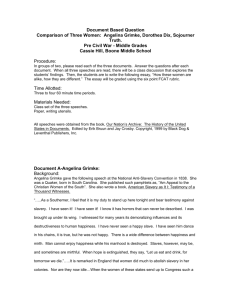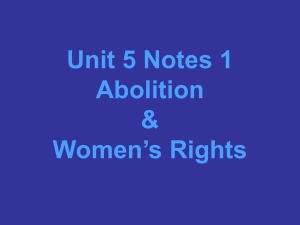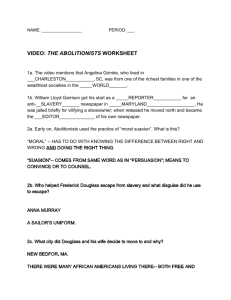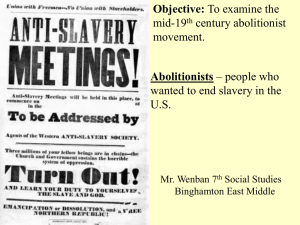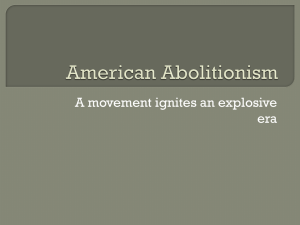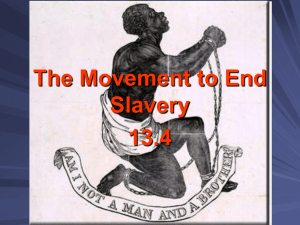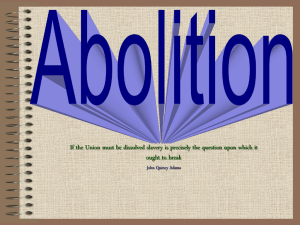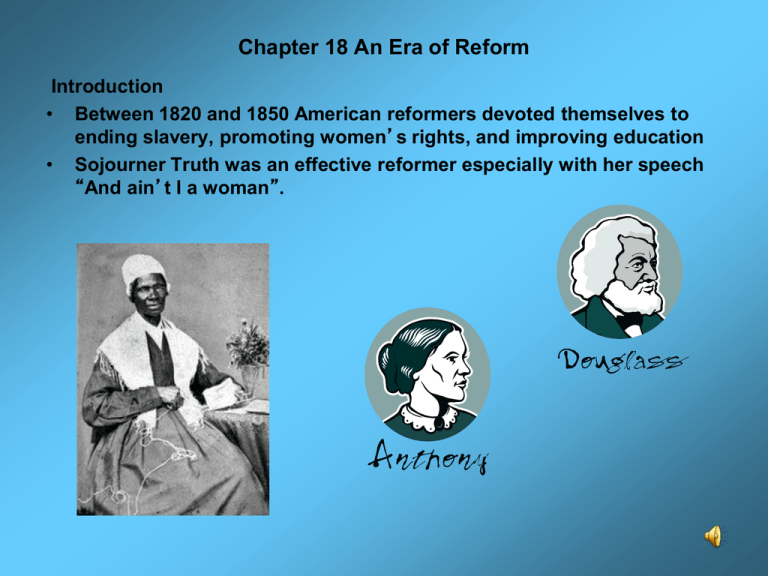
Chapter 18 An Era of Reform
Introduction
• Between 1820 and 1850 American reformers devoted themselves to
ending slavery, promoting women’s rights, and improving education
• Sojourner Truth was an effective reformer especially with her speech
“And ain’t I a woman”.
Ain’t I a Woman
18.2 The Spirit of Reform
•
•
•
•
•
New religious movements played a key role in inspiring Americans to
remake society
The Second Great Awakening was a religious revival in the 1820s and
1830s
Leader of the movement was Charles G. Finney
The revival fired people’s emotions
Preachers told people that they could gain
forgiveness and be saved by doing good works
* It gave men and women a reason to work for the improvement of
society
18.2 Optimistic Ideas
•
•
•
•
Ralph Waldo Emerson was a central figure in a movement called
transcendentalism
Said people had to “transcend” or go beyond logical thinking and find
answers to life’s mysteries by learning to trust their emotions and intuition
(felt people were basically good and would do the right thing)
Urged people to question society’s rules and institutions
Henry David Thoreau (Emerson’s friend) spent 2 years in solitude to learn
to be without rules of society
Ralph
Waldo
Emerson
Henry David Thoreau
Quotations from Emerson
Biography of Thoreau
18.2 Model Communities
•
•
•
•
Brook Farm was an experiment in creating a perfect community
Residents shared the labor of supporting themselves by farming, teaching,
and making clothes
Most of these communities lasted only a few years
They did symbolize the belief that people of good will could create an ideal
society
Brook Farm String Quartet
Brook Farm
18.3 Reforming the Treatment of Prisoners and the
Mentally Ill
•
•
•
•
Dorothea Dix was instrumental in reforming conditions of prisoners
Saw inmates bound in chains and locked in cages
Children were jailed with adult criminals
Dix visited jails, prisons, and hospitals to witness conditions
18.3 Plight of the Mentally Ill and Campaigning for Better Conditions
•
•
•
•
•
•
Dix was shocked at the way mentally ill were treated
Believed that the mentally ill needed treatment and care, not
punishment
Dix prepared a report for the Massachusetts state legislature
Lawmakers voted to create public asylums
Dix campaigned for the rest of her life
By 1887 debtors were no longer put in prison; special justice systems
were created for children in trouble; and cruel punishment was
outlawed
18.4 Improving Education
• Next reform movement was to make education available to
more children
• Led by Horace Mann “the father of American public schools”
18.4 Need for Public Schools
•
•
•
•
•
•
•
Puritans established town schools
A few areas had public schools
Wealthy parents sent their children to private schools
Most children simply didn’t go to school at all
Reformers believed education would help children in cities escape poverty
and become good citizens
New York was first state to make public schools in every town
Massachusetts voted to pay taxes to build better schools, pay
teachers higher salaries, and establish training school for teachers
18.4 An Unfinished Reform
•
•
•
•
•
By 1850, most white children, ESPECIALLY BOYS, attended free
public schools
Most high schools and colleges didn’t admit women
Most blacks were kept out of public schools
Blacks were made to go to separate
schools that received less to no money
Horace Mann encouraged students to
become involved in improving society:
“Be ashamed to die until you have won
some victory for humanity”
18.5 Fighting Slavery
•
•
•
•
•
•
•
•
If America was the land of the free, how could it allow slavery?
People who wanted to end slavery were called abolitionist
By 1792, majority of states had anti-slavery societies
Slave trade ended in 1808
Northern shipping communities didn’t have any more interest in slaves but
liked the cheap cotton that the south provided using slave labor
Disagreement on how to end slavery:
a. radicals: inspire slaves to rise up in revolt
b. pacifists: find a peaceful solution immediately
c. moderates: give slaveholders time to develop new farming methods
that didn’t need slaves
In 1831, William Lloyd Garrison started an abolitionist newspaper the
Liberator
Said “I will be as harsh as truth”
William Lloyd Garrison
18.5 Frederick Douglass Speaks Out
•
•
•
Douglass became a leader in the abolitionists movement
Started a newspaper the North Star
Newspaper’s motto was “Right is of no sex – truth is of no color –
God is the father of us all, and we are all Brethren.”
Biography of Douglass
James Earl Jones reads Frederick Douglass
18.5 Women Get Involved
•
•
Angela and Sarah Grimke spoke out about the poverty and pain of
slavery
They led the way for other women to speak in public
Sarah Grimke
Angelina Grimke
Abolitionist meeting
Grimke Sisters
18.5 Women Get Involved
•
•
•
•
•
Sojourner Truth, a former slave, was an abolitionist
She argued that God would end slavery peacefully
Abolitionists were a minority and there was violence directed toward them
The violence helped change northerner’s attitude toward slavery
Women’s anti-slavery fight started the next reform movement for
women’s rights
Abolitionist meeting turned
violent
Sojourner Truth
18.6 Equal Rights for Women
• Women abolitionists tried to convince lawmakers to make slavery
illegal but they couldn’t vote or hold office
• Women’s money and property were controlled by fathers and
husbands
• Husbands could discipline wives whenever they wanted
• Struggle for women’s rights began with Lucretia Mott and Elizabeth
Cady Stanton
Lucretia Mott
Elizabeth Cady
Stanton
18.6 Unequal Treatment of Women
•
•
•
Lucy Stone refused to pay property taxes because she said women had no
representation
Elizabeth Blackwell wanted to be a doctor but no medical school
would allow her
She was finally accepted and became the first female doctor
Medical degree
Elizabeth Blackwell
18.7 The Seneca Falls Convention and the Declaration of
Sentiments
•
•
•
•
Lucretia Mott announced a women’s convention in Seneca Falls, New
York
The convention started on July 19, 1848
Abolitionists, Quakers, local housewives, farmers, and factory workers
attended
Wrote up a proposal called the Declaration of Sentiments based on the
Declaration of Independence
“We hold these truths to be self-evident that all men and women are created
equal”
Cady and
Stanton
Declaration of
Sentiments
Lucretia
Mott
Women’s Suffrage
18.7 Legacy of Seneca Falls
•
•
•
•
•
•
•
Convention voted to approve the
idea that women should have the
right to vote
The Convention helped to create
an organized campaign for women’s
rights
Susan B. Anthony traveled from
town to town speaking for women’s
rights
Reformers for women’s rights
made progress
New York gave women control
over their property and wages
Some states passed more liberal
divorce laws
Blackwell started her own hospital
to train female doctors

